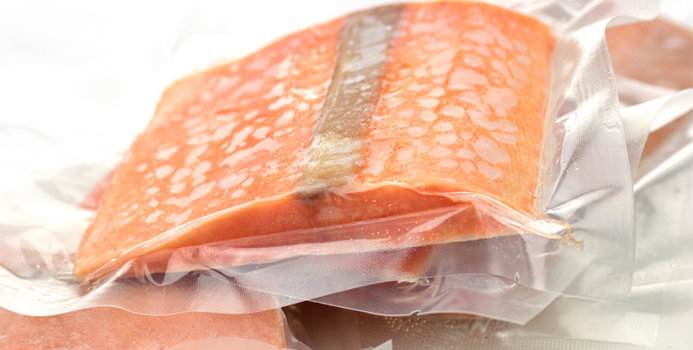Fish is a popular protein source because in addition to being relatively lower in calories, saturated fats and cholesterol, fish is high in health fats like omega 3's and 6's, and lots of B-vitamins. Having fish as a regular part of your diet is associated with reducing the risk of coronary heart disease, and helping maintain mental and visual function. But often fresh fish are expensive and need to be quickly used, so frozen fish or flash-frozen fish become a better options.
When buying frozen fish you want to make sure that it has been properly frozen, has a mild fresh odor, limited amount of ice crystals and no freezer burn. Freezer burn causes drying and discoloration of the fish. You also need to make sure you have a food thermometer, so that you can easily tell when your fish has reached 145 degrees internally to avoid overcooking. Cooking time is usually doubled for frozen fish from whatever a recipe states for fresh fish.
But how do you get frozen fish back to that fresh fish flavor?
Tip 1: Partial Thawing
One of the best ways to prepare frozen fish is to rinse it under cold water until it no longer has ice crystals. Then rub it in olive oil and bake between 425-450 degrees for 3-5 minutes, remove and add additional marinate and spices. Then returned the fish to the oven to continue cooking for 8-15 minutes or until is baked and flaky all the way through.
Partial thawing is also useful for adding fish to stir-frys, once the fish thaws enough to cut with a knife, cut the fish into thin uniformed sized strips. Add marinate to the fish, then add fish to a lightly oiled wok or non-stick skillet. Cook on medium high heat until hot. Add vegetables and noodles after you are sure the fish has been thoroughly heated.
Fish quickly absorbs marinade, usually in under 15 minutes.
Best spices to cook with finfish: basil, thyme, tarragon, bay leaf, sage, oregano, paprika, ginger, chili powder, dill, and fennel.
Tip 2: Steaming
Choose a frozen fish filet, steak or whole fish and place on a lightly oiled piece of foil. Then rub the fish with vegetable oil, herbs, lemons or mango salsa, fresh basil and fold into a packet. Place in an oven on high heat, or around 450 degrees and cook for 8-15 minutes.
Another steaming option is to place rinsed frozen fish on a steamer pan/perforated tray and steam with bok choy, onions, leeks, and other vegetables over a pan of simmering water. Continue steaming until fish is thoroughly thawed and the fish flakes.
Even a microwave can be an excellent way to cook frozen fish. Place in a microwave-safe dish, add a small amount of broth or liquid to the dish, place fish in and cover with a lid. Microwave on high until the fish flakes. Steam your vegetables the same way until they are tender.
Tip 3: Stewing
Once you have mostly thawed your fish, cover it in seasoned flour and slowly brown on both sides in a small amount of vegetable oil. Poor off any liquid accumulated and add liquid broth to a small pan. Bring liquid to a simmer and cover the pan with the fish in it. Cook on a low heat simmer until the fish is fork tender.
Tip 4: Poaching
Poaching frozen fish can be a quick and delicious way to prepare fish. Take your rinsed frozen fish and place in a mix of vegetable broths, water, or even wine. Season with spices like dill, peppercorns, lemon, bay leaves and fennel then bring to a boil. Once boiling, reduce the heat, cover the pan and simmer the fish until it is thawed and easily split with a fork.
You can also pre-simmer vegetables like carrots, onions, celery, zucchini or scallions in the broth for a few minutes prior to adding the fish and then cook everything together to a tender mouthfeel. Fish should quick faster in this method, especially dependent on the size but between 3-8 minutes for fillets.

Emily DeLacey MS, RD is a Registered Dietitian and currently working in Jamaica as a HIV/ AIDS Prevention Specialist. She attended Central Washington University for her Bachelor's Degree in Science and Dietetics and continued on after her internship to Kent State University for her Master's Degree in Science and Nutrition, with a focus on public health and advocacy. She served as a U.S. Peace Corps Volunteer in Malawi 2012-2014 working as a Community Health Advisor in a rural village, immersing in the joys of life without electricity or running water. She has been to 20+ countries and 47 of the 50 states in the US. Traveling, adventuring and experiencing new cultures has made her a passionate advocate for the equality of nutrition and wellness for all people.



